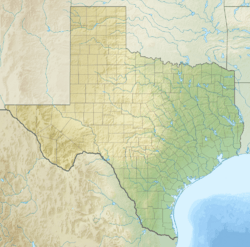Fort Richardson (Texas) facts for kids
|
Fort Richardson
|
|

|
|
| Nearest city | Jacksboro, Texas |
|---|---|
| Area | 42 acres (17 ha) |
| Built | 1867 |
| NRHP reference No. | 66000816 |
Quick facts for kids Significant dates |
|
| Added to NRHP | October 15, 1966 |
| Designated NHL | November 27, 1963 |
Fort Richardson was an important United States Army base in what is now Jacksboro, Texas. It was named after Union General Israel B. Richardson. He passed away during the American Civil War at the Battle of Antietam. The fort was active from 1867 to 1878.
Today, the area is known as Fort Richardson State Park, Historic Site and Lost Creek Reservoir State Trailway. You can still see some of its original buildings. In 1963, it became a National Historic Landmark. This was because it played a big part in keeping the northern part of Texas safe after the Civil War.
Contents
Fort Richardson's Story
Building a Frontier Fort
Fort Richardson helped many people move to and settle in north-central Texas. It was one of several forts built along the Texas frontier. These forts were meant to protect settlers and encourage them to move west. Other forts in this system included Fort Griffin, Fort Concho, and Fort Davis National Historic Site. There were also smaller outposts between the main forts.
The army first planned to build the fort near Buffalo Springs. This spot was about 20 miles (32 km) north of where Fort Richardson is now. However, that location wasn't good. It didn't have enough trees or water. Also, Native American groups often raided the area. Because of these dangers, a town called Henrietta was even abandoned in 1862. So, the U.S. 6th Cavalry Regiment decided to move south to the current location.
Life at the Fort
Construction of Fort Richardson began in 1867. The U.S. 6th Cavalry Regiment built it on a 300-acre (121 ha) site. It was located along Lost Creek, which flows into the Trinity River. The fort cost about $800,000 to build and opened on November 26, 1867. It became a key part of the frontier fort system. It was also the last army post in North Texas on the military road to Fort Sill.
The fort started with five army companies. Later, it grew to hold ten or more companies. In 1872, it had 666 officers and soldiers. This made it the largest U.S. Army base in the country at that time. Famous cowboy writer Frank H. Maynard visited Fort Richardson in 1872.
Many different army units served at Fort Richardson. These included the 6th Cavalry Regiment and the 4th Cavalry Regiment. The U.S. 11th Infantry Regiment also served there. Parts of the 10th Cavalry Regiment and 24th Infantry Regiment (United States) were also stationed at the fort. These two were Buffalo Soldier regiments, made up of African American soldiers.
Life for soldiers at Fort Richardson was tough. They had to go on long, difficult patrols. These patrols covered a wide area from Clay and Jack Counties to Palo Duro Canyon near Amarillo. Soldiers often had battles with Comanche and Kiowa groups. The army wanted to protect settlers and stop attacks.
Important Events and Battles
In 1871, General William T. Sherman visited the fort. He was touring the frontier forts. He just missed a major event called the Warren Wagon Train Raid. After this raid, General Sherman went to Fort Sill. There, he arrested Kiowa chiefs Satanta and Big Tree. They were sent to Jacksboro to face trial for their part in the attack.
In July 1871, the chiefs were tried and found guilty. They were the first Native Americans to be tried in a Texas civil court. Their sentences were later changed to life in prison.
After these events, General Sherman gave Colonel Ranald S. Mackenzie permission to act. Colonel Mackenzie commanded the 4th Cavalry. He began operations against the Comanche and Kiowa in the Texas Panhandle. One of his scouting parties fought in the Battle of Palo Duro Canyon in September 1874. This was a victory for the U.S. Army. It helped end the Red River War with Quanah Parker's Comanches and Red Warbonnet's Kiowas. The cavalry captured so many supplies from the tribes. This forced them to return to reservations in Oklahoma before winter. This battle was very important. It helped stop the Comanche and Kiowa raids along the northern frontier of Texas.
Fort Richardson Today
From Abandonment to Park
After the army's victory, Fort Richardson was no longer needed. The army left the post on May 23, 1878. For a short time, it was used as a school for Native American children. The 55 buildings, many made of stone, slowly fell apart.
However, a group of people from Jacksboro worked to save the fort. In 1963, it was named a state historic site. The Texas Parks and Wildlife Department began managing it. Major repairs and restoration started in 1968. In 1973, it reopened as Fort Richardson State Historic Park.
Visiting Fort Richardson
Today, the site is called Fort Richardson State Park, Historic Site and Lost Creek Reservoir State Trailway. Visitors can explore seven original buildings that have been restored. These include the old hospital, officers' living quarters, and the powder magazine. You can also see the morgue, commissary, guardhouse, and bakery.
There are also two replica buildings. These are copies of the enlisted men's barracks and the officers' barracks. They now house the Interpretive Center. This center helps visitors learn more about the fort's history. Guided tours of the buildings are offered every day.
Gallery
See also









